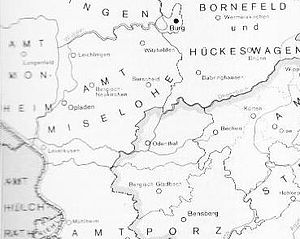Office Miselohe
The Office Miselohe was an administrative and judicial district in the Duchy of Berg .
history
Miselohe is one of the eight old Bergisch offices , which were first mentioned in a document dated September 6, 1363 and originated in the late High Middle Ages (second half of the 14th century), when the Counts of Berg increasingly developed into sovereigns. The offices brought together several parishes in the administrative administration. The Office Miselohe comprised essentially the area of today's cities Burscheid , Leichlingen (Rheinland) with Witzhelden and Leverkusen (excluding the districts of Hitdorf and Rhine village that belonged to the neighboring office Monheim), as well as parts of Odenthal - the municipality in the Rheinisch-Bergisch district to which is the seat of origin of the Counts von Berg in Altenberg .
A large forest between Dhünn and Wupper gave Miselohe its name, which means something like mouse or rabbit forest .
The office had no permanent administrative center until its dissolution. The town of appointed by the sovereigns bailiff (comparable today with a district administrator) served as administrative center. However, from the middle of the 14th century the office had a permanent court seat in Opladen , today a part of Leverkusen. At the beginning of the 19th century the offices were dissolved, the Miselohe office was assigned to the Solingen district.
The lower district of Solingen, later renamed the Rhein-Wupper district , always saw itself as the material and ideal successor to the Bergische Ämter Hückeswagen , Monheim and Miselohe in its area . Since 1975, the urban area of Leverkusen has comprised most of the former administrative area. Miselohestrasse in Leverkusen is a reminder of this historic office.
Structure of the office
The Miselohe office comprised ten parishes (population 1792):
| Parish | Belonging | Residents | religion |
|---|---|---|---|
| Bourgeois | House Reuschenberg | 400 | Catholic |
| Burscheid |
Ober- , Mittel- , Unterhonschaft ; Landscheid house, Rötzinghofen house, Bellinghausen house |
2,843 | Lutheran |
| Corpses |
Bruckerhonschaft with Haus Forst and Haus Balken; Spinnerets ; Rödelerhonschaft with Haus Nesselrode and Diependahl |
2,505 | Lutheran |
| Lützenkirchen | Upper, middle, lower honors | ? | Catholic |
| Neukirchen | Atzlenbach and Biesenbach | 1,307 | Lutheran |
| Opladen | Ophoven | 504 | Catholic |
| Schlebusch | Knight seats Schlebusch and Schlebuschrath , House Morsbroich | 1,047 | Catholic |
| Steinbüchel |
Knight's seat Steinbüchel; Localities Fettehenne, Gronenborn, Nieder-Blecher |
871 | Catholic |
| Wiesdorf | 689 | Catholic | |
| Joke heroes | House Höhscheid | 1,359 | Lutheran |
Bailiffs
The following officials are documented:
- 1311: Roland called bow, advocatus
- 1389: Giso von Zweifel, amptman zue Meysseloe
- 1633–1650: Hans Degenhard von Hall zu Uphoven
- 1792: Franz Karl von Loë (1720-)
- ? : Gerhard Anton Aussuerus Edmund von Loë (1749–1813), later French senator
See also
Web links
literature
- Albrecht Brendler: On the way to the territory. Administrative structure and office holder of the County of Berg 1225–1380 . Inaugural dissertation, Bonn 2015, pp. 151–162.
Individual evidence
- ^ Main State Archives Düsseldorf : Berg, Document 354; published by Theodor Joseph Lacomblet : Archive for the history of the Lower Rhine. Volume 4. Voss, Düsseldorf 1863, pp. 147–158 ( digitized version )
- ^ Hermann Hengstenberg: The former Duchy of Berg and its immediate surroundings , Elberfeld 1897, p. 25 ( Düsseldorf State Library )
- ^ Wilhelm Fabricius : Explanations of the historical atlas of the Rhine province, Volume 2: The map of 1789. Bonn 1898, p. 318
- ↑ Brendler (2015), p. 162.
- ↑ Renate Leffers: The neutrality policy of Count Palatine Wolfgang Wilhelm as Duke of Jülich-Berg in the period 1636–1643 , Bergische Forschungen, Volume VIII, Neustadt an der Aisch 1971, p. 94.
- ↑ History of the Cologne, Jülich and Berg families, family table Hall
- ↑ Niederrheinisch-Westphälischer Kreis-Kalender to the year 1792, p.156
- ↑ Gothaisches genealogical pocket book of the count's houses, 1872, p.489

